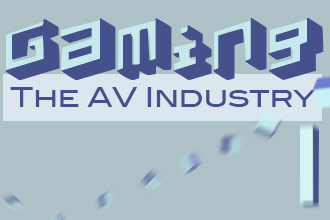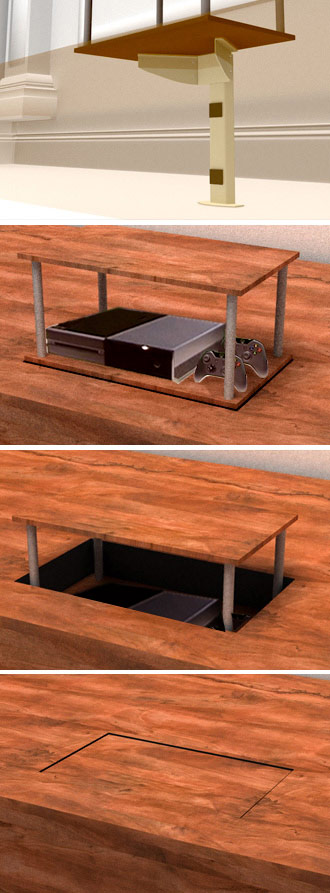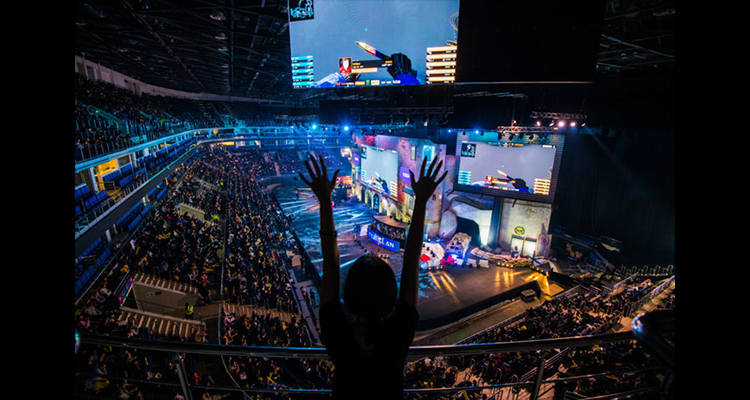Gaming the AV Industry: Lift Off!
 I’m sticking to my promise, and this will be my first article featuring specific ways to add value to your game-centric home theater setup. It may actually be too specific, in that you’ll have to do some custom woodwork until and unless an AV furniture company starts selling similar products. But I’m getting ahead of myself.
I’m sticking to my promise, and this will be my first article featuring specific ways to add value to your game-centric home theater setup. It may actually be too specific, in that you’ll have to do some custom woodwork until and unless an AV furniture company starts selling similar products. But I’m getting ahead of myself.
When it comes to console placement, there have been two main ways to go about it: rackmount or placing it in an ungainly pile near an HDMI wall input. For 99 percent of AV equipment, rack-mounting is the cleanest and most professional way to deal with source equipment. Game consoles are a unique exception — they frequently require manual interaction. Inserting game discs, manual resets and the plugging and un-plugging of peripherals. If the rack is located in a different room or hidden away in some way, the constant up and down is not ideal. The other issue with remote location difficulty comes from the game motion sensors. Currently, there are no extension solutions for next generation console cameras, and you will be limited to the length of that cable to the front of the room; The Wii U is the exception to this.
One more reason to keep the equipment accessible is that many game enthusiasts LIKE the equipment. It’s analogous — although on a different financial plane — to people who buy stereo loudspeakers, high-end turntables and tube amplifiers that are standalone sources of pride.
On the other end of the game integration spectrum, I’ve seen several setups that involve an HDMI and audio port wall plate located near the stage or a wall on a bookshelf. This is closer to ideal, but a pile of cords and controllers really lacks professionalism and looks like an afterthought. It also does not leave much room for custom integration in a way that adds value that you can bill on an invoice.
 My solution — a custom rising stage platform. It’s a idea very similar to the motorized flat-panel mounts that you can integrate into credenzas and the foot of beds. The placement will enable sensor cables to easily reach below the screen. I did some searching, and there are not many motorized AV mounts meant to deal with flat equipment, which makes sense. You wouldn’t want your amplifier to rise out of furniture because there’s no point when you can just use control and IR. So, I looked to a different market and discovered sewing machine electric and pneumatic rising mounts. They let people integrate the machines into desks and free up the space when not in use. These mounts are about 12 inches high, so if you are customizing a stage at the front of the room, you’re going to have to take that height into account.
My solution — a custom rising stage platform. It’s a idea very similar to the motorized flat-panel mounts that you can integrate into credenzas and the foot of beds. The placement will enable sensor cables to easily reach below the screen. I did some searching, and there are not many motorized AV mounts meant to deal with flat equipment, which makes sense. You wouldn’t want your amplifier to rise out of furniture because there’s no point when you can just use control and IR. So, I looked to a different market and discovered sewing machine electric and pneumatic rising mounts. They let people integrate the machines into desks and free up the space when not in use. These mounts are about 12 inches high, so if you are customizing a stage at the front of the room, you’re going to have to take that height into account.
I would recommend making the platform wide enough to accommodate a console and charging stands for controllers. Run power underneath the stage, and make a run to the rack with HDMI and optical audio; maybe flat-mount some AV and USB outlets in the bottom plate. The really tricky bit is going to take some woodworking skill. You’ll need two pieces of wood stained or painted to match the stage surface and four posts (your choice of materials). If you can’t match the stage surface, I would make it an obvious contrasting color. The stage itself will then need a very careful hole cut out with a jigsaw. How much labor does this come out to? I would conservatively estimate three hours of shop-time and four hours in the theater. How much you could invoice for depends on the clients, but I feel you could make a healthy profit.
The resulting product is flexible and turns the console into a theater showpiece. Scaling this up to four side-by-side lifts wouldn’t increase your time costs by much and improve what you could bill the customer for. The other upside for the customer is they can switch out the console as new hardware is released in the coming years. Currently there are no comparable products in the rack and AV furniture spaces — but I think this would be a great product to offer commercially, frankly. I feel the best way to sell this option would be to add one to your demo rooms, as it would be really visual and tactile offering.
So what say you, reader? Am I way off base, or is this a value-add that you could pitch to game-obsessed customers?





